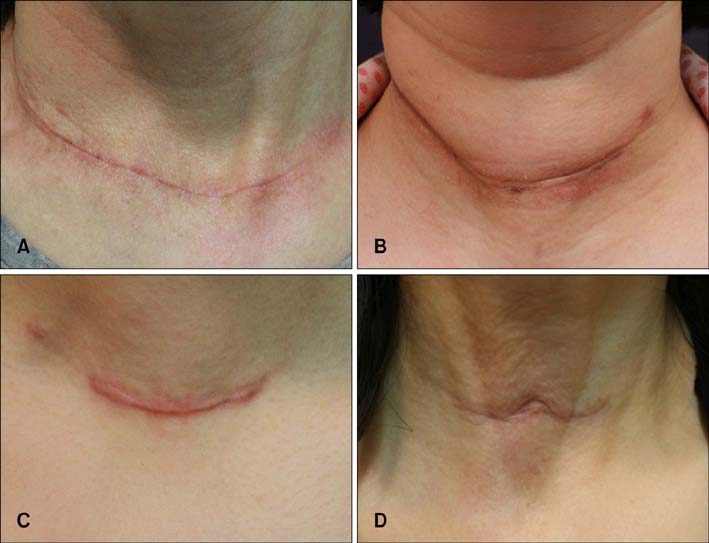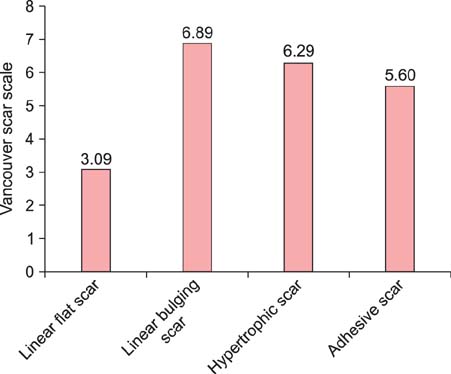Ann Dermatol.
2014 Dec;26(6):693-699. 10.5021/ad.2014.26.6.693.
Impact of Postthyroidectomy Scar on the Quality of Life of Thyroid Cancer Patients
- Affiliations
-
- 1Department of Dermatology, Gangnam Severance Hospital, Cutaneous Biology Research Institute, Yonsei University College of Medicine, Seoul, Korea. karenroh@yuhs.ac
- 2INC Research, Wilmington, NC, USA.
- 3Department of Surgery, Thyroid Cancer Center, Gangnam Severance Hospital, Yonsei University College of Medicine, Seoul, Korea.
- KMID: 2264863
- DOI: http://doi.org/10.5021/ad.2014.26.6.693
Abstract
- BACKGROUND
Surgical scars are crucial cosmetic problem, especially when in exposed areas such as the anterior neck following thyroidectomy.
OBJECTIVE
To evaluate the impact of post-thyroidectomy scars on quality of life (QoL) of thyroid cancer patients and identify the relationship between scar characteristics and QoL.
METHODS
Patients with post-thyroidectomy scars on the neck were recruited. QoL was measured using the Dermatology Life Quality Index (DLQI). Scar characteristics were graded according to Vancouver scar scale (VSS) score.
RESULTS
Ninety-seven patients completed a battery of questions at the time of enrollment. Post-thyroidectomy scars were classified according to morphology as linear flat scars, linear bulging scars, hypertrophic scars or adhesive scars. There were 32 patients (33.0%), 9 patients (9.3%), 41 patients (42.3%) and 15 patients (15.5%), respectively, in each group. The mean total DLQI score was 9.02. Domain 2 (daily activities, 2.87 points), which includes questions about clothing, was the most greatly impacted among patients. The total DLQI scores of patients who have experienced scar-related symptoms were significantly higher than those of patients without symptoms (p<0.05). The VSS scores were 3.09 for linear flat scars, 6.89 for linear bulging scars, 6.29 for hypertrophic scars and 5.60 for adhesive scars. However, the DLQI scores did not significantly differ among scar types or VSS scores.
CONCLUSION
Post-thyroidectomy scars on the neck affect the QoL of thyroid cancer patients regardless of scar type. Therefore, clinicians should pay attention to the psychological effects of scars on patients and take care to minimize post-thyroidectomy scar.
MeSH Terms
Figure
Cited by 3 articles
-
Factors Influencing Quality of Life in Thyroid Cancer Patients with Thyroidectomy
Jiyeon Yang, Myungsun Yi
Asian Oncol Nurs. 2015;15(2):59-66. doi: 10.5388/aon.2015.15.2.59.Values of a Patient and Observer Scar Assessment Scale to Evaluate the Facial Skin Graft Scar
Jin Kyung Chae, Jeong Hee Kim, Eun Jung Kim, Kun Park
Ann Dermatol. 2016;28(5):615-623. doi: 10.5021/ad.2016.28.5.615.Benefits and Limitations in Transoral Endoscopic Thyroidectomy
Yong Tae Hong
Korean J Otorhinolaryngol-Head Neck Surg. 2023;66(1):1-6. doi: 10.3342/kjorl-hns.2022.01018.
Reference
-
1. Han MA, Choi KS, Lee HY, Kim Y, Jun JK, Park EC. Current status of thyroid cancer screening in Korea: results from a nationwide interview survey. Asian Pac J Cancer Prev. 2011; 12:1657–1663.2. Duncan TD, Rashid Q, Speights F, Ejeh I. Transaxillary endoscopic thyroidectomy: an alternative to traditional open thyroidectomy. J Natl Med Assoc. 2009; 101:783–787.
Article3. Balci DD, Inandi T, Dogramaci CA, Celik E. DLQI scores in patients with keloids and hypertrophic scars: a prospective case control study. J Dtsch Dermatol Ges. 2009; 7:688–692.
Article4. Finlay AY, Khan GK. Dermatology Life Quality Index (DLQI)--a simple practical measure for routine clinical use. Clin Exp Dermatol. 1994; 19:210–216.
Article5. Jin-gang A, Sheng-xiang X, Sheng-bin X, Jun-min W, Song-mei G, Ying-ying D, et al. Quality of life of patients with scabies. J Eur Acad Dermatol Venereol. 2010; 24:1187–1191.
Article6. Brown BC, McKenna SP, Siddhi K, McGrouther DA, Bayat A. The hidden cost of skin scars: quality of life after skin scarring. J Plast Reconstr Aesthet Surg. 2008; 61:1049–1058.
Article7. Hongbo Y, Thomas CL, Harrison MA, Salek MS, Finlay AY. Translating the science of quality of life into practice: What do dermatology life quality index scores mean? J Invest Dermatol. 2005; 125:659–664.
Article8. Idriss N, Maibach HI. Scar assessment scales: a dermatologic overview. Skin Res Technol. 2009; 15:1–5.
Article9. Davies L, Welch HG. Increasing incidence of thyroid cancer in the United States, 1973-2002. JAMA. 2006; 295:2164–2167.
Article10. Wang Y, Wang W. Increasing Incidence of Thyroid Cancer in Shanghai, China, 1983-2007. Asia Pac J Public Health. 2012; [Epub ahead of print].
Article11. Bargren AE, Meyer-Rochow GY, Delbridge LW, Sidhu SB, Chen H. Outcomes of surgically managed pediatric thyroid cancer. J Surg Res. 2009; 156:70–73.
Article12. Tan CT, Cheah WK, Delbridge L. "Scarless" (in the neck) endoscopic thyroidectomy (SET): an evidence-based review of published techniques. World J Surg. 2008; 32:1349–1357.
Article13. Alvarado R, McMullen T, Sidhu SB, Delbridge LW, Sywak MS. Minimally invasive thyroid surgery for single nodules: an evidence-based review of the lateral mini-incision technique. World J Surg. 2008; 32:1341–1348.
Article14. Kent G, al-Abadie M. Factors affecting responses on Dermatology Life Quality Index items among vitiligo sufferers. Clin Exp Dermatol. 1996; 21:330–333.
Article15. Dolatshahi M, Ghazi P, Feizy V, Hemami MR. Life quality assessment among patients with vitiligo: comparison of married and single patients in Iran. Indian J Dermatol Venereol Leprol. 2008; 74:700.
Article16. Parsad D, Pandhi R, Dogra S, Kanwar AJ, Kumar B. Dermatology Life Quality Index score in vitiligo and its impact on the treatment outcome. Br J Dermatol. 2003; 148:373–374.
Article17. Lin TY, See LC, Shen YM, Liang CY, Chang HN, Lin YK. Quality of life in patients with psoriasis in northern Taiwan. Chang Gung Med J. 2011; 34:186–196.18. Misery L, Finlay AY, Martin N, Boussetta S, Nguyen C, Myon E, et al. Atopic dermatitis: impact on the quality of life of patients and their partners. Dermatology. 2007; 215:123–129.
Article19. Mazzotti E, Barbaranelli C, Picardi A, Abeni D, Pasquini P. Psychometric properties of the Dermatology Life Quality Index (DLQI) in 900 Italian patients with psoriasis. Acta Derm Venereol. 2005; 85:409–413.
Article20. Rapp SR, Feldman SR, Exum ML, Fleischer AB Jr, Reboussin DM. Psoriasis causes as much disability as other major medical diseases. J Am Acad Dermatol. 1999; 41:401–407.
Article21. Bock O, Schmid-Ott G, Malewski P, Mrowietz U. Quality of life of patients with keloid and hypertrophic scarring. Arch Dermatol Res. 2006; 297:433–438.
Article22. Gauglitz GG, Korting HC, Pavicic T, Ruzicka T, Jeschke MG. Hypertrophic scarring and keloids: pathomechanisms and current and emerging treatment strategies. Mol Med. 2011; 17:113–125.
Article
- Full Text Links
- Actions
-
Cited
- CITED
-
- Close
- Share
- Similar articles
-
- Clinical Factors Associated with Quality of Life in Patients with Thyroid Cancer
- Observation of changes in quality of life for 5 years after thyroid surgery: an observational cross-sectional study in Korean population
- Factors Influencing Quality of Life in Thyroid Cancer Patients with Thyroidectomy
- Postthyroidectomy obesity in a Korean population: does the extent of surgery matter?
- Assessment and research of quality of life in gynecologic cancer patients




